
Berthe Morisot, Self-portrait, 1885 (detail). © Musée Marmottan Monet, Paris.
Dulwich Picture Gallery, London
31 March – 10 September 2023
by JULIET RIX
This is, shockingly, the first major Berthe Morisot exhibition in Britain since 1950. Long overdue, it brings the original female impressionist before a new generation of British art lovers, as well as highlighting newly established connections with 18th-century art, including English art, gleaned from archival material given by the artist’s family to Paris’s Musée Marmottan Monet.
The French museum, home to more Morisot paintings than any other institution, has partnered with Dulwich Picture Gallery, lending 14 works (several previously unseen in the UK) to the show, which will travel to Paris after its run in London.
Morisot (1841-95) greets us at the door, standing tall and confident, in her 1885 impressionist self-portrait, palette in hand. This sets the tone for an exhibition dedicated to a woman who – unusually at a time when women were not even admitted to France’s official art school – established herself as an artist in her early 20s, exhibiting at the Paris salon of 1864. She went on to be admired and accepted as an equal by her now globally famous male impressionist colleagues: Claude Monet, Edgar Degas, Camille Pissarro, Pierre-Auguste Renoir, and Morisot’s great friend and brother-in-law, Édouard Manet.

Berthe Morisot, Resting, 1892. Oil on canvas. Private Collection
Beside the self-portrait hangs a pair of pictures, Summer’s Day (1879) and In the Bois de Boulogne (1879), that instantly connect Morisot to Renoir and Manet. These images show the same two women in the Paris park, painted, as was characteristic of the impressionists, outside (en plein air). The women are professional models and one of them later recalled that Morisot often required her to arrive at 6.30am when there were no curious crowds to interfere with outdoor painting. By 9am the work was done, “and we returned to her home for a cup of coffee”.
“As a woman – particularly an upper-class woman – Morisot could not frequent and paint the late-night cafes and theatres as the male artists did, so she painted outside or in private spaces,” observes the show’s co-curator and originator, Lois Oliver. Morisot was a key player in the impressionist group, but her subject matter sets her a little apart. Morisot herself said: “My ambition was limited to wanting to capture something of what goes by, just something, the smallest thing,” and she tends to focus on women, often alone, in quieter, reflective moments.
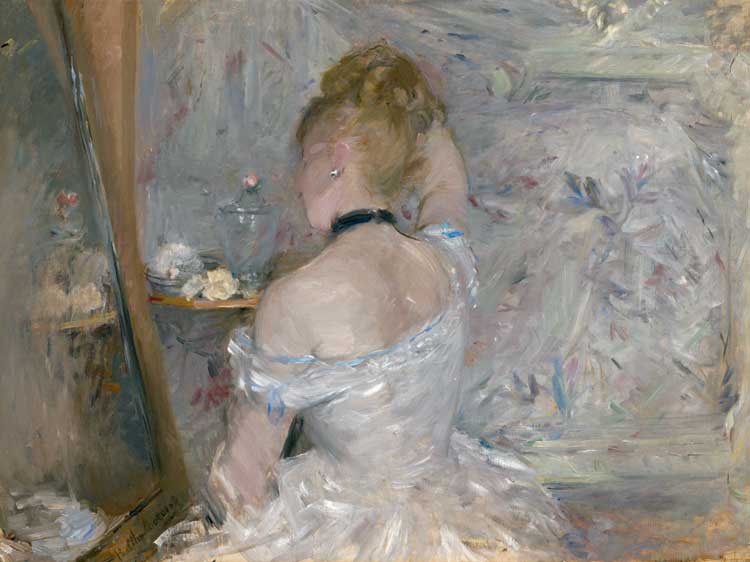
Berthe Morisot, Woman at her Toilette, 1875-80. Image courtesy of The Art Institute of Chicago, Stickney Fund.
Woman at Her Toilette (1875-80) shows a young lady seated at a dressing table. It is an impressionist feast of whites and greys, full of “hidden” pinks and blues, creating a shimmering silvery whole, the woman almost merging with her surroundings – surroundings that are, in fact, Morisot’s own bedroom.
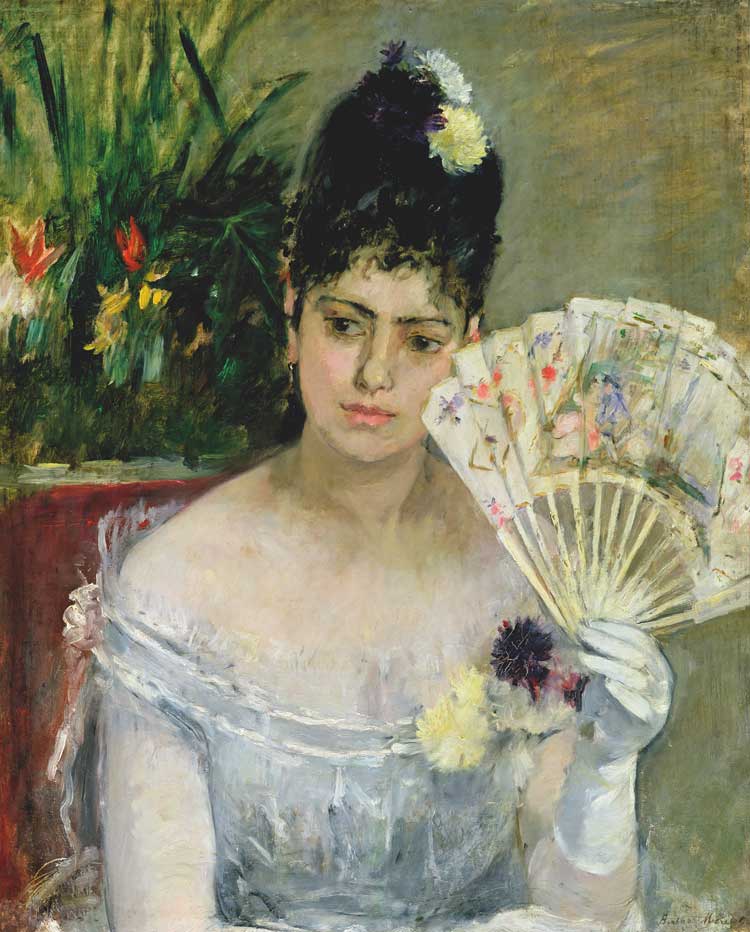
Berthe Morisot, At the Ball, 1875. © Musée Marmottan Monet, Paris.
Even when her subject is a mass gathering such as a ball, Morisot eschews the crowd scenes typical of Renoir, Manet or, indeed, the London-based French artist James Tissot whose The Ball on Shipboard (c1874) hangs in the next room. Instead, she concentrates on individuals and introspection, as seen here in both At the Ball (1875) and Young Woman in a Ballgown (1879).
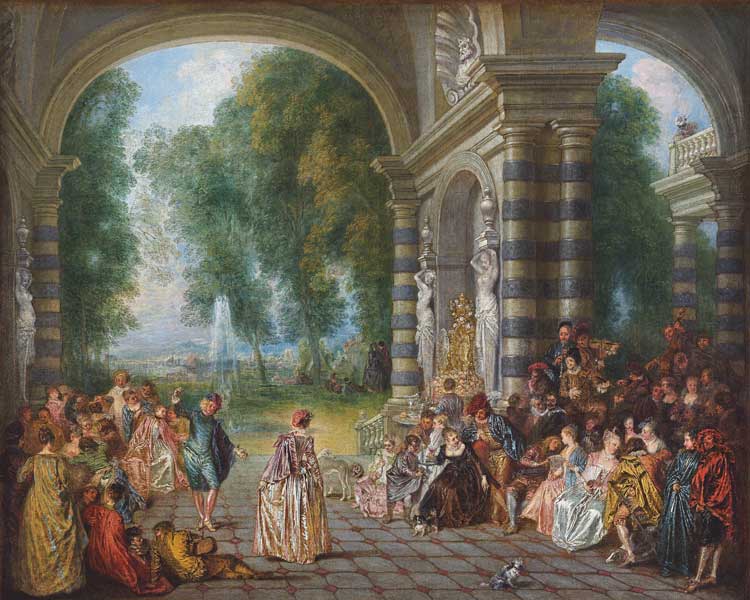
Antoine Watteau, Les Plaisirs du bal, c1715-17. Courtesy Dulwich Picture Gallery.
At the Ball brings us close-up to one young lady in evening dress looking out from behind her elegant fan. The 18th-century fan, itself painted with a Watteau-style fête galante courtship scene, was Morisot’s own and pleasingly is itself present in the exhibition, occupying a vitrine below the painting. The fan in Morisot’s composition was the artist’s first pictorial allusion to the 18th century, but by no means her last – and the cross-century connection was made by several contemporary artists and critics.
During the 1880 Impressionist exhibition (the group’s fifth), the critic Philippe Burty reviewed Young Woman in a Ballgown: “Madame Berthe Morisot handles both palette and paintbrush with truly surprising delicacy. Not since the 18th century, not since Fragonard, have such pale colours been applied with so much boldness of spirit.” And Paul Maritz wrote of At the Ball: “Everything floats, nothing is formulated … there is here a finesse like that found in Fragonard.”
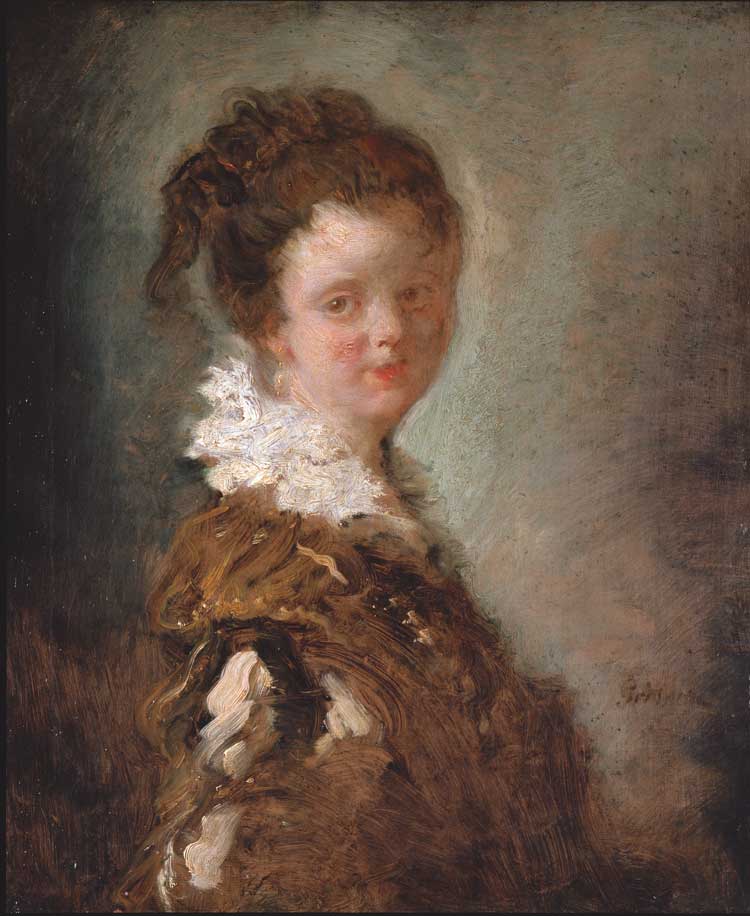
Jean-Honoré Fragonard, Young Woman, c1769. Courtesy Dulwich Picture Gallery.
Comparison with Jean-Honoré Fragonard (1732-1806), whose work was just coming back into fashion in France after a post-revolution slump, perhaps short-changes the innovation and emotional content of Morisot’s art. The work of the rococo Fragonard was much more what we might today call “fluffy”, prioritising hedonism, eroticism and surface shine. Contemporary critics, though, clearly intended the comparison as a compliment to Morisot’s painterly skills. Nor is there any doubt that she herself, though at the forefront of developments in her own time, admired 18th-century art, making Dulwich, with its 18th-century-rich permanent collection, a particularly appropriate venue for this show.
The fan is just the start. When Morisot married Eugène Manet (brother of Édouard) in December 1874, shortly after the first impressionist exhibition, in which she was the only female exhibitor, the couple decorated their home in 18th-century style. Their Louis XVI bed features in the background of Woman at Her Toilette, and Morisot echoes 18th-century compositions, particularly in her use of the reclining pose, represented here by Reclining Woman in Grey (1879) and Young Girl Reclining (1893).
In her notebook in 1885, Morisot mentions her admiration for portraits of Madame de Pompadour by François Boucher (1703-1770) and Reclining Woman in Grey hangs beside a similarly posed – but stylistically contrasting – portrait of Louis XV’s remarkable female favourite and prominent patron of the arts, attributed to Boucher.
There are other interesting pairings. Fragonard’s The New Model (c1770) is displayed alongside Morisot’s The Mirror (1876). The Fragonard depicts a fancily dressed artist auditioning a new model. He lifts her skirt to check out her ankles, while the model’s mother lowers the girl’s blouse to show off her youthful breasts. A picture of this sort was usually bought by men to enjoy in private and when this painting was shown in a large public exhibition in Paris in 1860 it caused a sensation. Morisot’s “version” may have appealed to a similar market, but it is quite different. Her model stands alone before a full-length mirror quietly admiring herself. Her bare ankles in yellow shoes are visible below her hemline, her dress has slipped just slightly off her shoulder, and the whole is set not in a studio but in the private space of Morisot’s bedroom.
A further pairing reaches across the Channel; Morisot’s Winter, depicting a Parisienne wrapped up for cold weather, hangs next to George Romney’s Mrs Mary Robinson (1780-81). Morisot’s painting echoes not only the scale, pose and composition of the clothes in Romney’s portrait but even the woman’s gaze.
Several of the impressionists spent time in London (particularly during the Franco-Prussian war of 1870), but the men were mostly interested in English landscape paintings, particularly by JMW Turner. Morisot, however, is drawn to the portraitists, commenting favourably on those most English of English 18th-century artists Sir Joshua Reynolds, Romney and Thomas Gainsborough.
In the summer of 1875, Morisot and Eugène took their honeymoon in England. On the Isle of Wight, which was exceptionally fashionable at the time due to Queen Victoria’s passion for Osborne House, they attended regatta week, and Morisot painted Eugène looking out of the window of their holiday cottage (one of her very few pictures of a man). He was apparently a terrible sitter and certainly looks as if he would rather be outside the window than inside being painted, but it is a charming, layered little painting full of light and translucence (and just the right size to take home, says Oliver mischievously).
Morisot was considering making her career in England, but found English high society too rich and too cliquey. The art, however, seems to have made a more favourable – and lasting – impression. In a little shop on the island, Morisot found a Reynolds for “two francs” (presumably a small drawing or print) and in London she visited the National Gallery and the Kensington Museum (now the V&A) as well as various private collections.
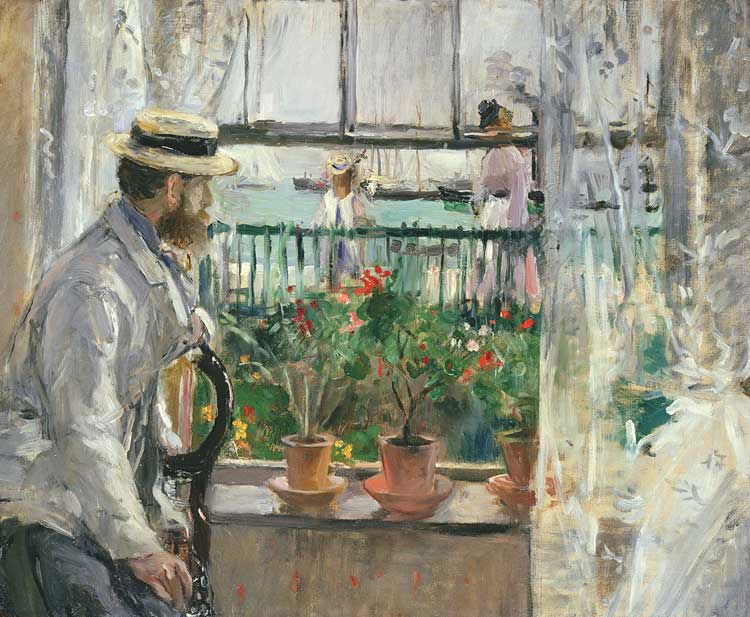
Berthe Morisot, Eugène Manet on the Isle of Wight, 1885. © Musée Marmottan Monet, Paris.
She seems to have been particularly engaged by portraits of women and children, such as Reynolds’ Angels Heads (1786-87) and Gainsborough’s Blue Boy (c1770). Morisot subsequently attempted a “blue” portrait of her own, and after her return to France, her “brushwork became more broken, reminiscent of Gainsborough,” says Oliver. Comparison of Eugène Manet on the Isle of Wight (1875) and later paintings such as Reclining Woman in Grey (1879) and Paule Gobillard in a Ballgown (1887) speaks to this, though Morisot’s style remains entirely her own.
Children – and one child in particular – feature increasingly in her work after the birth of her daughter, Julie Manet, in 1878 when Morisot was 37. In The Fable (1883), four-year-old Julie sits outside amid blossom and flowers telling a story to a listening servant, while in Children with a Basin (1886), the artist’s daughter plays with the child of their Paris concierge. The vibrancy of the brushstrokes in this painting makes it the most kinetic in the show. The children’s joyful motion highlighting how still (despite the vitality of the brushwork and light) is most of Morisot’s art.
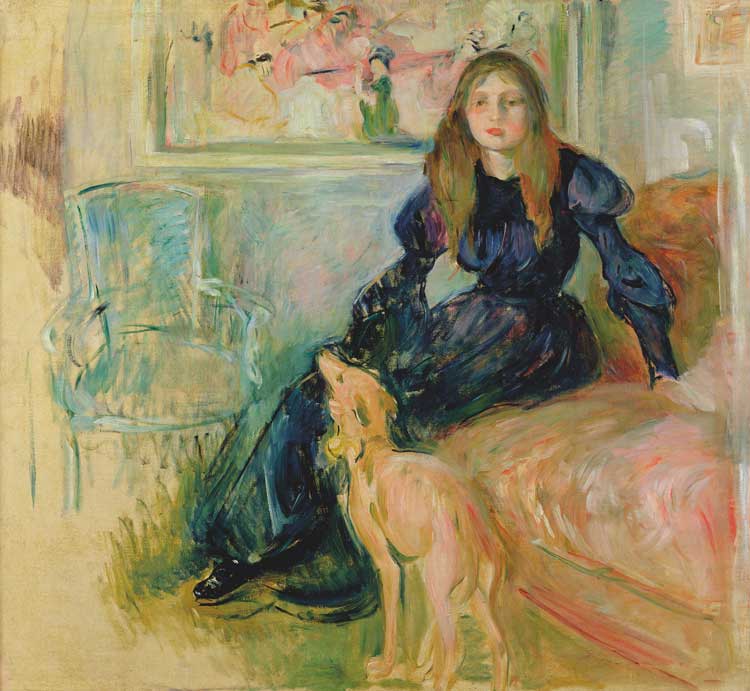
Berthe Morisot, Julie Manet with her Greyhound Laerte, 1893. © Musée Marmottan Monet, Paris.
The show ends with Julie aged 14, wearing a black dress, in mourning for her father, stroking the pet dog bought to console her (Julie Manet and her Greyhound Laerte, 1893). An 18th-century blue chair stands symbolically empty beside her. The painting is particularly poignant when you know that her mother died less than two years later, succumbing at the age of 54 to flu (which led to pneumonia) after nursing Julie through the illness.
Admired and celebrated in her lifetime, Morisot fell into relative obscurity after her death. Was this due to her more feminine subject matter? “There was possibly a 20th-century male/patriarchal strand of art history that left out domestic paintings,” says Oliver, “but that wasn’t how her contemporaries saw it and the male impressionists did domestic pictures too.”
Oliver believes that it has more to do with public exposure: “In the UK, Samuel Courtauld gave us his extraordinary collection of French impressionists, and he donated £50,000 to the National Gallery to acquire French modern art, but he provided a list of 25 artists to be included – and there were no women.
“And when Morisot died, her paintings were Julie’s legacy. She was still a child, so they stayed in the family, limiting public awareness of her work … It shows how important public collections are.”
In adulthood, Julie was active in promoting her mother’s work and instrumental in the staging of the 1950 London exhibition. In life, Morisot was an integral part of the impressionist inner circle. This exhibition is a step towards putting her back where she belongs.